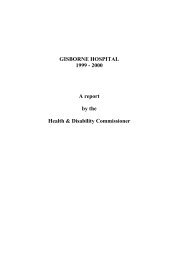09HDC01565 - Health and Disability Commissioner
09HDC01565 - Health and Disability Commissioner
09HDC01565 - Health and Disability Commissioner
Create successful ePaper yourself
Turn your PDF publications into a flip-book with our unique Google optimized e-Paper software.
<strong>Health</strong> <strong>and</strong> <strong>Disability</strong> <strong>Commissioner</strong><br />
86. The nursing h<strong>and</strong>over took place in the seminar room at approximately 6.45am. RN<br />
Ms J told HDC that this had already become usual ward practice by the time of her<br />
orientation to the SCU two years earlier. Mr A‘s care was h<strong>and</strong>ed over to RN Ms K,<br />
who recalls being told that all of the postoperative patients had had uneventful<br />
nights. 26 The only point of note in relation to Mr A was that he snored heavily but was<br />
easily roused. RN Ms K recalls that she was told Mr A‘s vital signs were stable.<br />
Specific figures were not reported, as was usual when signs were normal <strong>and</strong> there<br />
was no apparent cause for concern.<br />
87. RN Ms J subsequently told HDC that it was usual practice for one nurse to remain at<br />
the nurses‘ station during h<strong>and</strong>over, <strong>and</strong> that it was possible from there to hear the<br />
alarms on the oxygen monitors in SCU. She states that following h<strong>and</strong>over that<br />
morning, she relieved the RN at the nurses‘ station for a few minutes while that nurse<br />
gave her h<strong>and</strong>over, <strong>and</strong> that Mr A‘s monitor did not alarm during this time. This<br />
indicated to her that Mr A‘s saturation levels were above 92%.<br />
88. RN Ms K states that h<strong>and</strong>over finished at approximately 7.05am, after which she <strong>and</strong><br />
her colleagues went to the nursing office, where they discussed their workload, teams,<br />
<strong>and</strong> staffing for the shift. RN Ms K states that there were no specific concerns about<br />
workload or patient allocation, so she was in the nursing office for approximately one<br />
minute. She collected the clinical records <strong>and</strong> drug charts for the patients under her<br />
care, checked that none of the medications due at 7am required checking by two<br />
nurses or were medications not held in SCU, <strong>and</strong> proceeded to SCU.<br />
89. All three patients were due to be observed at the same time. RN Ms K recalls that<br />
when she entered the room, she noticed that the curtain was pulled around Mr A‘s<br />
bed, although from her position in the room she could not tell whether it was<br />
completely drawn or whether there was a gap near Mr A‘s head. She later said it was<br />
not unusual for curtains to be closed for short periods, for example when a patient is<br />
having a catheter inserted, or has visitors. RN Ms K recalls that she did not hear any<br />
snoring, which she took to mean Mr A was either awake or sleeping in a position that<br />
did not partially obstruct his airway. His snoring had been reported as intermittent.<br />
90. As she entered the room, the patient from bed space one was coming out of the<br />
bathroom. She spoke with this patient, who was keen to be discharged <strong>and</strong> had some<br />
questions about this. RN Ms K said at the same time she noticed that the patient in<br />
bed space three appeared to be sleeping. The sleeping patient‘s monitor was switched<br />
on, <strong>and</strong> indicated that his pulse <strong>and</strong> oxygen saturation levels were within acceptable<br />
levels. She therefore proceeded to record the observations of the ambulatory patient<br />
first. RN Ms K estimates that she would have been with this patient for approximately<br />
five minutes.<br />
91. She then moved on to the patient in bed space three, who by this time had woken up<br />
<strong>and</strong> appeared to be in some pain. She was about to record his limb strength when she<br />
realised she had Mr A‘s chart. She crossed out the recordings she had already made in<br />
Mr A‘s chart, <strong>and</strong> re-entered the information on the correct chart. RN Ms K recalls<br />
26 RN Ms K was a Level 5 RN.<br />
5 September 2012 16<br />
Names have been removed (except Canterbury DHB <strong>and</strong> the experts who advised on this case) to<br />
protect privacy. Identifying letters are assigned in alphabetical order <strong>and</strong> bear no relationship to the<br />
person’s actual name.
















